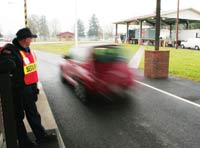Following the Sept. 11, 2001, terrorist attacks, the government instituted increased levels of security planning for critical infrastructures in the United States. Not surprisingly, the petrochemical industry is one of 14 sectors deemed by the Patriot Act of 2001 to be of high criticality and sensitivity.
- By Bill Livingstone, Howard Kympton
- Feb 01, 2009
Smiths Detection recently announced a $3.5 million contract with the United States Marshals Service for HI-SCAN 6046si advanced X-ray screening systems. The systems will be installed in courthouse lobbies throughout the United States to screen personal belongings of those entering the building.

A modern, new 250-bed jail will soon replace the currently overcrowded 98-bed facility in Midland County, Mich., and digital video surveillance technology from Panasonic System Solutions Company will boost security at the $25 million, 103,000-square foot facility.
Rampart Partners LLC, a business consulting firm focused on the security industry, recently announced that its founders Robert Rutkowski and Joseph Costa are joining forces with Scott Greiper, formerly a managing director at Legend Merchant Group and head of the firm's Convergent Security Group. The three business and security industry experts have launched a new entity called Secure Strategy Group.
Magal Security Systems recently announced that it has received, through its U.S.-based subsidiary, an order to supply a security and protection system for a major United States international border crossing. The order is expected to be delivered during 2009.

With more than 2 million people expected to attend the historic swearing in of President-elect Barack Obama, 58 law enforcement agencies in the District of Columbia and surrounding jurisdictions will rely on Alert DC, an interoperable emergency text messaging system provided by Cooper Notification, to coordinate the largest security and safety operation for a presidential inauguration in the nation’s history.

The combination of security and efficiency can sometimes appear to be the equivalent of oil and water. We have all felt the delays associated with tightening security procedures at government buildings and facilities. Depending on the location, these delays can sometimes last 10 to 30 minutes—or more. For people who enter these facilities regularly, this burden can have a large impact on their day.
- By James Robell, Jennifer Fritz
- Jan 01, 2009
Since 1965, the Delaware Capitol Police has worked to ensure that the state government can operate safely and uninterrupted. The agency’s responsibilities include protecting legislators while in session, safeguarding the governor’s mansion and residence, and servicing approximately 100 state buildings. Over time, the number of state buildings has increased, along with the agency’s scope of responsibilities.
- By Michael Bliss
- Jan 01, 2009
The Department of Defense issues Common Access Cards to more than 4 million military, retried military and contractors throughout the world. DoD was tasked with complying with the Federal Information Processing Standards Publication 201. FIPS 201 is a federal government standard that specifies Personal Identity Verification requirements for Federal employees and contractors.
The Transportation Security Administration has approved four biometric readers from Sagem Morpho for deployment in critical pilot tests of the Transportation Worker Identification Credential program at major U.S. ports including Los Angeles, New York and Long Beach, Calif.
A recent report from Research and Markets says that even in the government sector, initiatives such as e-passports and RFID enabled ID cards are expected to drive demand for RFID hardware.
GE Security, Inc., a business of GE Enterprise Solutions, recently announced the company has modified its contract with the General Services Administration (GSA) to update the schedule of available GE Security products.
U.S. federal government identity and smart card programs have grown significantly under the Bush administration. But with the election a week away, one important question on people's minds is, what will happen under the next administration?

Airport officials at the Draughon-Miller Central Texas Regional Airport in Temple, Texas, can now watch over ground crews and protect military assets using a wireless video surveillance network.
Hirsch Electronics, a supplier of physical access control systems, has signed an exclusive global distribution agreement with SCM Microsystems, a supplier of smart card readers for secure authentication, to provide SCM’s Physical Access Control Terminals (PACT) series physical access readers to the open market.
HID Global recently announced that it has been selected to supply its Fargo HDP5000-LC printer/encoders to the Department of Defense Defense Manpower Data Center. As part of the DMDC’s migration to the next generation of ID card printers, the HDP5000-LC units will be utilized throughout the DMDC to support its Identity Protection and Management projects.
AtHoc Inc. recently announced that the Air Force Materiel Command (AFMC) has expanded its use of AtHoc IWSAlerts within the command. AFMC awarded a contract for AtHoc software licenses and services, and the emergency notification system is now deployed to an additional 25,000 people.

The United States Postal Service (USPS) recently announced the implementation a multi-site, technologically-advanced video security program. With more than 40,000 sites across the country, the USPS has selected Diebold Security to manage this nationwide implementation under a three-year agreement.
Driven by Homeland Security Presidential Directive 12 (HSPD-12) goals and implementations, CoreStreet recently announced that the Department of Veteran Affairs (VA) will leverage CoreStreet’s credential validation technology for the validation services required as part of its HSPD-12 smart card program.